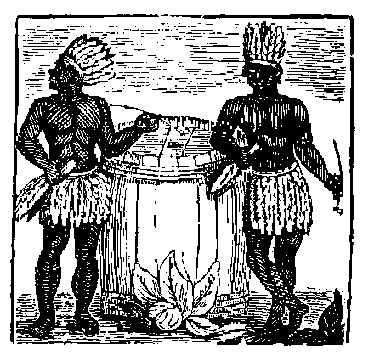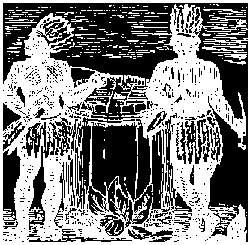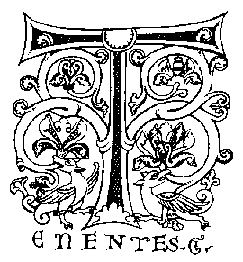U. S. Hegemony
In a "Post-Phallic" Era
Cynthia Weber
(Minnesota)

While the camera captures Castro's image, it also conjures up an aura of mystery and intrigue about him, affected by the shaded area in which he is standing, his unmanicured beard, and his olive fatigues and cap. The photo is cropped so that Castro's legs are not visible, making the focus of the photo Castro's broad chest. In case his military uniform and manly stature are not sufficient to underscore Castro's masculinity, Castro holds across his body a large rifle. This prop transforms his image from one of masculinity to hypermasculinity...
This is just the beginning. Before Castro, Cuba was ambivalent, feminine --- now it is all man. The Caribbean Sea is a mirror, and too, a "see," making it possible for us to see ourselves: we can see it as "water, womb, and woman." Maurice Bishop of Grenada is quoted as saying, "We are a lot like Americans. If you kick us in the shins, we will kick you in the balls." When Ronald Reagan went into politics, he was merely continuing his role in B-movies, so that when he was asked what kind of governor he would make in California, he said, "I don't know. I've never played a governor."
Weber quotes Antonio Benítez-Rojos to the effect that Europe conceived
- the project of inseminating Caribbean womb with the blood of Africa; the Atlantic is today the Atlantic because it was the painfully delivered child of the Caribbean, whose vagina was stretched between continental clamps...all of Europe pulling on the forceps to help at the birth of the Atlantic.
 Then there's The Panama Canal, that feminine slit across the continent, stroked by Manuel Noriega and his three yachts: Macho I, Macho II, and Macho III. Finally, if this hasn't gotten up your gorge, or George, there's President Bush, saying "read my lips," but really telling us, according to the author, "read my vulva." Eh?
Then there's The Panama Canal, that feminine slit across the continent, stroked by Manuel Noriega and his three yachts: Macho I, Macho II, and Macho III. Finally, if this hasn't gotten up your gorge, or George, there's President Bush, saying "read my lips," but really telling us, according to the author, "read my vulva." Eh?
Flowers from the
The sixteen illustrators preparing drawings for Kew Magazine (from whence these come) had to choose color emphasis, layout, background illustration, and peripheries, and their works are not without a simple and direct artfulness. Ms. Stiff has chosen drawings for aesthetic merit as well as appropriate illustration of plant types, and please don't eat the Streptocarpus saxorum!
Royal Gardens of
Kew
Ruth L. A. Stiff
(University Press of New England)
The Extraordinary
True Story
Janet Gleeson
(Warner)
The Arcanum is a mildly interesting disquisition on the evolution alchemy, and its somewhat parallel discipline, that of the making of fine porcelain in Europe. Because of the huge demand for fine china, one who could figure out how it was made to the East would be as rich as one who could grow gold. Great china originally came from China, natch (that's where it got it's name, dummy. It came from the Hebei province, wherever that is). It's fine, thin, and translucent, and the process of making it was a well-kept secret. In the 18th Century, a certain Augustus the Strong, King of Poland, chanced across Johann Bëttger, an alchemist. Now the claim of alchemists --- that they could transmogrify base metal into gold may seem to us a fairly stupid idea now --- but Gleeson makes convincing evidence that, given the knowledge of the time, it made some sense.
Rocks and metals, like plants and animals, were believed to grow spontaneously. While an animal grew in the womb of its mother or a plant blossomed from the soil, minerals were born from seeds of metal deep within the earth and grew with the assistance of natural forces into large nuggets and seams.
You could grow feldspar or iron, but, of course, gold was the desideratum:
The philosopher's stone, lapis philosophorum or red tincture, was, they believed, a substance contained in the earth through which metal travelled in order to transmute into gold. Thus, by finding or fabricating this compound, harnessing nature with the help of planetary or divine assistance, and speeding up the usual growth process in their laboratory, any metal might be transmuted into gold.
We have here not only a description of the 18th century equivalent of finding another AOL or Amazon.com before it goes public, but the birth of the twentieth century scientific technique. The experimental methods practiced by Bëttger (tiny variations in the ingredients and the method of cooking them together; extensive, exhaustive notes; immense patience, were, according to the author, two centuries ahead of their time.)
Like any modern scientist, Bëttger was exact, and by his experiments with the superheating of the clays of Saxony, he stumbled over two --- kaolin and alabaster --- which finally gave him fine China, the one that the patron was so eager to cash in on. Alas, his work did him in. Augustus was a bit suspicious. As Bëttger led him on to think he had the philosopher's stone, so Augustus dangled rewards --- often promised, never given --- while he kept him a prisoner in one of his castles. The author guesses that the dreadful working conditions, and the inhalation of noxious gasses, finally did him in.
The Arcanum is good on the scientific method (and wild beliefs) for 250 years ago; but only so-so on the built-in drama of the situation. By the way, the word "porcelain" comes from the Latin porcellus, which means "little pig." Or, "vulva." So watch it when you ask for your tea in a porcelain cup.
Loves
That
Bind
Julián Ríos
Translated by
Edith Grossman
(Knopf)

To thicken the plot, each one of these ladies is, according to the publisher, drawn on the character of a fictional lady of the same name. Thus Q is Quentin from The Sound and the Fury, M is Molly Bloom from Ulysses, D is Daisy from The Great Gatsby. This may be fun while we are reading the ones we can figure out --- but presents us with puzzles as we are wandering through the other letters in this alphabetical Casanova soup. Who in the hell is P? Could it be Pocahontas (lake references, Indians, birds flying, "First kiss, underwater. Grebe-style...standing next to the canoe...")
U? Can it be Ursula from Women in Love? Y has something to do with Mexico, maybe Under the Volcano, but we tried that one last year and petered out after the ninth binge. The New York Times nabbed a few last summer: ''B'' is Bonadea from Robert Musil's Man Without Qualities, ''F'' is Florence Dowell from Ford Madox Ford's Good Soldier. And H is Hermine from Hermann Hesse's Steppenwolf, "a strange young woman," says the reviewer, "who wants to make the hero love her so much that he will agree to kill her."
Ríos --- or his narrator --- seems to have this thing about the very young. There's "L" for Lolita, but her narrative is quite wooden, nothing compared to the pesky pith of the original.
the freckled Saint Paul schoolgirl in shorts and white socks who made me wait with laughter and whispers, whispering and laughing on the telephone as she balanced a tennis racket with her right hand and from time to time coquettishly touched it to her calves. She looked at me, as if it meant nothing, and burst into giggles again.
Poor Humbert would never have her "burst into giggles again."
There's an overabundance of young ladies seduced by headmistresses, and nuns, and older lady friends. All this stylistic strutting is a bit like World Peace. The concept is fine, but the execution is a bit fuzzy. It's also a bit of braggadocio. How many of us have twenty-six loves --- make that twenty-seven with the one he's just lost --- floating around in our sex-brain? It's a tour d'horizon, or better, a tour de force --- but as far as we are concerned, there is too little tour and too much force; more like forcemeat. There are, indeed, moments of punning and pleasure,
And she would speak to him, finally, about Cliff, her first husband. Cliff: precipice...But the one who really went over the edge into cantinas would be her second husband. Steeply inclined to drink. And she, to the end, attempted to save her marriage. Through fire and water. Firewater to the very last drop of raving drunkenness and into ravines...This new consul, like her father, also turned to the bottle. (Consul...Qu'on saoule...Let's get drunk....)
For those of us addicted to writing and books, it should be a fun-filled romp, but we found ourselves getting bogged down in, not the ones we could figure out, but in those we couldn't, and the ones missing. Where's Annabelle Lee, for crumb's sakes? It's not under A --- that's given over to Albertine from Proust. There is W, all the references to the whips (wasn't Justine de Sade's lady? If we call her "Wustine" will she fit?)
On addition to tics, there are tricks: each chapter ends in the letter of the next chapter. Shakespeare is all over the place, but where the hell is Juliet, or Cleopatra, or the greatest hard-assed nut-yanking lover of all times, Sweet Lady Macbeth?
Loves That Bind becomes a rubric, a puzzle, one of those tedious anacrostics at the back end of Harpers or The New Yorker, and not much else. Ríos is just too clever for his own good.
As for the flow of a good novel? It just doesn't have it.